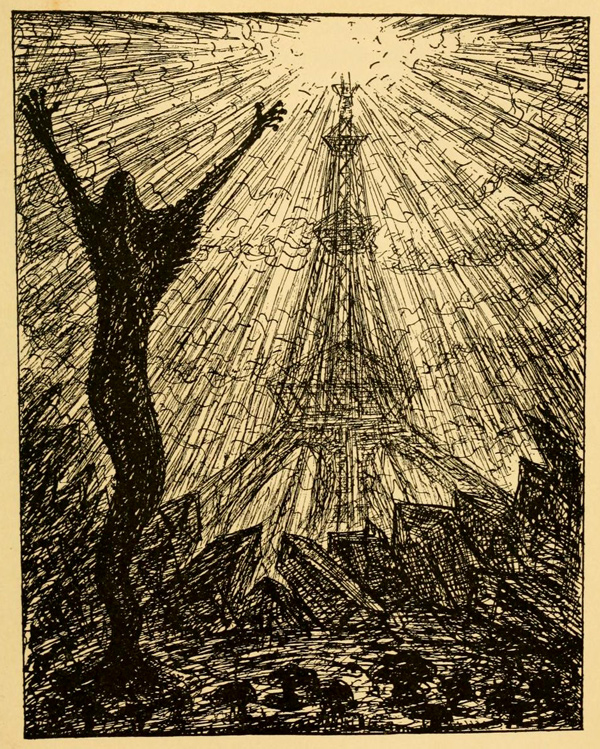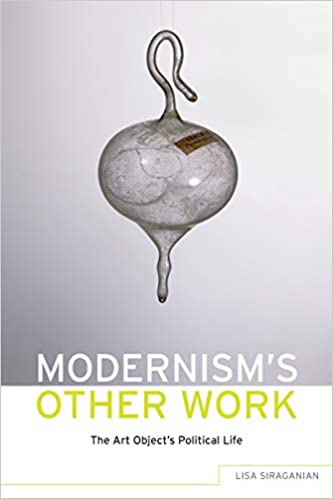The Meaning of Pain

Review of Paul Scheerbart, Lesabéndio: An Asteroid Novel. Illustrations by Alfred Kubin, translated, with an introduction, by Christina Svendsen. Wakefield Press, Cambridge, MA 2012. 232 pages.
Special thanks to the editors of Radical Philosophy for allowing me to reprint my review from issue 185 (May/June 2014): 64-65.
For admirers of the work of Walter Benjamin, a translation of Paul Scheerbart’s Lesabéndio: An Asteroid Novel is a major event. Benjamin continually lauded Lesabéndio throughout his life, most decisively in his famous vision of architectural politics, “Experience and Poverty” of 1933. Benjamin’s interest in Scheerbart spans the whole of his career, from Gershom Scholem’s gifting him the book at his wedding to an essay on Scheerbart written near the end of his life. Most significantly, Benjamin intended to write an extensive essay on the book that was meant as a fulfillment of the claims set out in “The Destructive Character” and was to be provocatively entitled “The True Politician.” As the Benjamin literature grows, so does Scheerbart’s reputation. Since 2007 there has been a dramatic rise in the stature of Scheerbart’s writings, including the translation of four books and a range of essays and artistic projects related to his work. At the center of Scheerbart’s current reputation is the identification of technology (glass and steel) and politics. As Josiah McElheny, the artist whose work has revolved around Scheerbart’s example in recent years, recently put it, the “most important aspect of Scheerbart’s thinking” is to see how his “world of fantasy was in fact his attempt to discuss politics by other means.”
Scheerbart’s 1913 sci-fi novel—undoubtedly his most significant literary achievement—provides another in a series of wildly ambitious architecturally-based explorations of utopia. The subject of the story is the construction of a gigantic tower by rubbery creatures called Pallasians who live on the planet Pallas. The tower is meant to connect the Pallasians with the “head-star” beyond an obscuring web-like cloud. A main dramatic current that runs throughout is the conflict between the artists (Labu, Manesi and Peka) who resist the building of the tower and the builders (Dex, Lesabéndio [or Lesa for short], Nuse and Sofanti). As the story unfolds, the artists are slowly and literally absorbed—destroyed—by the builders: the artists merge with the architects in an act of physical and metaphorical submission to the architects’ higher ambitions. The artists dream that after the construction of the tower “other times will come” that will provide a “solid new basis for art.” But the completion of the tower marks the end of art itself. Art pales before the architectural search to solve the “last riddle of existence.”
Contemporary critics have championed Scheerbart as a post-human visionary. Conceptually, we’re meant to measure with every phrase how different life is on Pallas than on earth. Earthlings exist in a “backward spiritual state” due to their resistance to the sun’s infinite metamorphic capacities. The sun “revitalizes everything around it” and it calls for a transparent architecture of glass to spread its transformative powers. “All death,” Biba (the wise philosopher) tells Lesa in his monologue on personhood, “should be ascribed to this broad, omnipresent principle of transformation.” And transformation is what occurs when Lesa reaches beyond Pallas’ atmosphere and connects with the head-system. He is “completely altered” by the merger and “everything…looks utterly different” from the new perspective.
At the center of Scheerbart’s utopian vision is an evolutionary scheme where lower forms are mentally and, more significantly, perceptually functioning on an inferior level. When a Pallasian visited earth he was unable to make himself perceptible to Earthlings due to the bluntness of their perceptual capacities. Because they are “stuck at such a low level of evolution” their mode of perception prevented them from seeing the more highly evolved Pallasians. The narrative follows Lesa’s attempt to overcome his evolutionary position by connecting with the head-star. “Everywhere I look I see matter ordering itself hierarchically below something greater than itself,” Lesa observes. “We should all seek our healing grace in this hierarchy.” Lesa, the “great leader” at the top of the Pallasian hierarchy, heals the Pallasians by marshalling them around the “colossal labor” of the tower construction. The monstrosity of work required to raise the tower—a central theme of the narrative—prevents the workers from getting lost in their “individual insights” and from destroying the utter unanimity of their task which alone will evolve the species. It is the task that defines the work’s meaning, not any “artistic intentions.” As one of the builders reflects, “we charged ourselves with a gigantic task before genuinely understanding why we’re doing it.” This is the kind of construction Detlef Mertins describes as a “kind of direct bodily production of labor, a potentially unmediated, collective physiological event in which dream-consciousness comes to realization.” In other words, there is nothing to understand, because it is the work itself—the back-breaking labor of working with steel and glass—that defines the work’s significance, rather any meaning to be found in the work. Intentions, artistic or otherwise, are identified with a lower level of evolution one that revolves around books and writing. “Sharing thoughts is accomplished…through books and other types of written signs,” both of which assume and reinforce an ideology of distance. Thoughts are not important for the “major astral beings” because they presume at least two separate agents, whereas the “formulation of new qualities” happens in the physical merger of formerly separate beings.
Lesa’s gospel is one of total renunciation: “one must subordinate oneself to something else over and over again.” His “religion” is one of “surrender,” “devoted submissiveness” through violent purgation toward “something greater than ourselves.” Leaping from the tower, Lesa will merge with the healing force of the head-system. Finally absorbed into the head-star what is revealed is how even the “most disparate come together”; once we move beyond all physical limitations the separate asteroids “unite” in a “big comet-system.” The newly discovered unity also projects a new sense of difference. With a set of “new eyeballs” Lesa discovers how asteroids could be unimaginably “varied and diverse.” Like Paul Klee’s Angelus Novus—which Benjamin explicitly imagined as a Lesa-like creature—he is “carried forward by a strong wind” and is only able to do “what the wind wants.” And like the Angelus Novus Lesa performs a relentless destruction of distance, “all he could feel was that he was noticing how everything distant wanted to come closer” thereby destroying every manifestation of “aura,” what Benjamin defined as a “phenomenon of distance, however close it may be.” Everything came “very close” to him—including other asteroids and the sun—and he felt “no obstacles or restraints anywhere.” Lesa comes to know the sun’s immense power of “drawing closer” the formerly disparate, a power which neutralizes any lingering auratic forces tied to “individual projects.” Individuality itself “push[es] us back down and prevent[s] us from reaching the being that so continuously and relentlessly desires the approach of those who are drawn to it.” Lesa’s primary ambition is to “demystify” the auratic cloud structure “by means of the tower”—something he continually stresses “has nothing to do with art”—and which will eventually break through it to the head-system. Achieving violent union with the head-system he “no longer perceived or thought in the ways he had before the transformation.”
If the sun represents a “spurting excess of life,” then the forces that resist it are rest, sleep, torpor, and habit. Before the construction of the tower the Pallasians are characterized as “tired, sleepy and drooping,” “want[ing] to die” they “habitually sleep” through much of their lives (although far less than humans). The artists represent this deadening force of routine and their aesthetic rests on a commitment to “matter,” to “density and compactness” which weighs down the immaterial forces of light suffused through glass. Scheerbart affirms the “perpetuum mobile of technology…and desire that foretells the posthuman adaptation,” Branden Joseph writes, he provides a cosmic vision of the “experiential poverty” of our contemporary condition. It is much harder to see what he provides—except buckets of pain—for those experiencing material poverty, rather than the experiential one.
Like most versions of the post-human, Scheerbart imagines that the process of going beyond will require immense suffering. We discover that the sun is far from “kind-hearted.” It is an instrument of terror. “Terrible things always leads us forward,” the sun tells Lesa; “Terrible things transform us.” Revitalization means death of the physical body and its mode of perception while “pain and suffering should actually be seen as the biggest generators of happiness.” The last four chapters offer an unrelenting vision of “pain and torment” as the path to evolution (this is what Benjamin means when he says Scheerbart “succeeded in shedding the dross of sentimentality”). Chapter 22 ends with an underscored phrase uttered by the sun that articulates the basic theme: “All of you, don’t fear pain—and don’t fear death either.” On the other side of the human “there is no concern for the smallest objects”; the sun “suffocate[s] anything trivial.” Rather “certain brutalities” are utterly necessary for progress. Lesabéndio introduces what Benjamin called the “positive concept of barbarism.” The new barbarism indicates how it is “only through difficulty do we arrive at the greatest ecstasies.” And again: “The greatest suffering and the greatest bliss…are almost inseparable.” This is something Lesa insists “one must get used to.” Lesa explains to the Pallasians that the “most important element of the great Sun philosophy is that…subordinating and surrendering are the greatest things.” “Dying is just another form of surrendering” and only for the “one willing to suffer will [he] always go farther.” The basic failure of the Pallasians, a habit they share with earthlings, is that “their lives flowed onward all too peacefully.” The last chapter is filled with the screams of the torpid Pallasians as their “old star is waking to a new life” under the influence of the light beaming down from the sun. “It’s bliss—once one has withstood of the process” of evolution, Lesa reflects. Lesa’s final meditation is a variant on the basic thought of the novel: “Surrendering oneself to a Greatness is very painful” to which the sun adds its thundering commentary, “As long as we fear neither pain nor death!”


